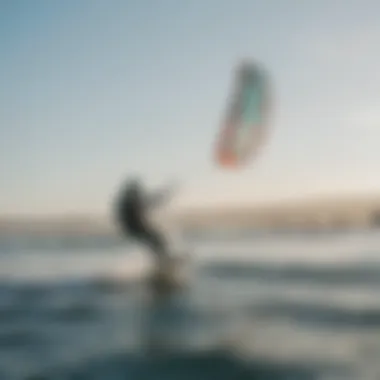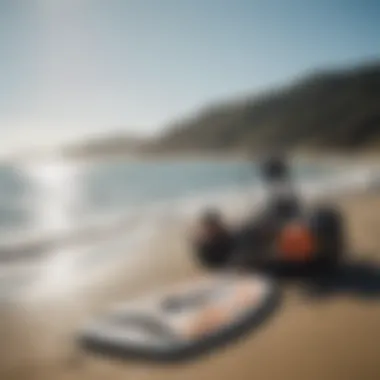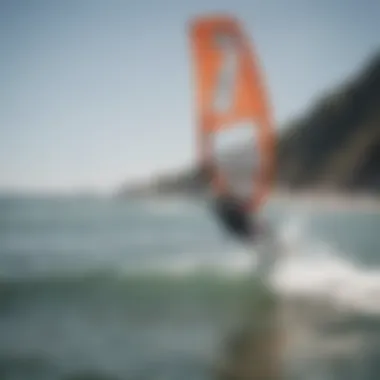Understanding Tides for Kiteboarding in Bodega Bay


Intro
Bodega Bay, California, is not just a picturesque coastal escape; it’s a prime location for kiteboarding enthusiasts. Understanding the tides here is crucial for maximizing your time on the water. Tides influence wind patterns, water levels, and overall conditions, making it vital for both newcomers and seasoned kiteboarders to grasp their nuances. This exploration aims to equip you with knowledge about tidal dynamics that can enhance your kiteboarding escapades.
By diving into the details, you will learn how the tides affect your ride, ecological impacts on the region, recommendations for gear selection, skill development tips, and necessary safety measures. Whether you're tackling the waves for the first time or aiming to perfect your skills, having a grip on the tides will make all the difference in your experience in the bay.
Gear Selection
Selecting the right gear can either make or break your kiteboarding session. It’s not merely about choosing a kite and a board but also about aligning them with the ever-changing conditions that the tidal environment presents.
Types of Kites
In Bodega Bay, the tide can play a considerable role in determining which kite will get you riding smoothly. You’ll want to consider the following varieties:
- C-Kites: Known for their freestyle capabilities, they perform well in higher winds but can be challenging in lighter breezes.
- Delta Kites: These are incredibly versatile and are preferred by many for their stability and ease of use across varying conditions.
- Bow Kites: Offering a larger wind range, bow kites provide fantastic lift and can help you navigate the shifting winds that the tidal changes can create.
When you pick a kite, take into account the wind speed at the time of your session and the tidal strengths expected for that day. The right choices could mean the difference between an exhilarating experience and a struggle against the elements.
Choosing the Right Board
Just as important as the kite is the board. Bodega Bay has unique underwater topography shaped by its tidal patterns, affecting how your board will perform. Consider these points:
- Directional Boards: Ideal for those who enjoy surf-style riding. These boards tend to be great when the tide is lower, allowing for smooth slicing through waves.
- Twin-Tip Boards: Best for beginners and intermediate riders, these boards are versatile and perform well regardless of the tide level, especially with shifting winds.
- Lightweight Boards: If you frequently navigate gusty conditions, opt for a lighter board to help with maneuverability.
Matching your board with the expected tide and wind conditions is vital. If the tide is coming in, a board that provides good lift will help you catch the waves better, while on a low tide day, a directional board might work wonders.
Skill Development
Kiteboarding isn’t all about the equipment; it also involves sharpening your skills to navigate the dynamic conditions of Bodega Bay. Proper techniques and tips can set you on the right path to becoming an adept kiteboarder.
Essential Techniques
To harness the power of the tidal changes effectively, focus on fundamental skills like:
- Mastering the Kite Control: Get comfortable flying your kite. It’s your muscle memory that’ll allow you to respond swiftly to tidal movements and changing winds.
- Water Starts: This is the key to getting up on your board, especially when dealing with varying water levels.
- Board Skills: Familiarize yourself with edging techniques to adjust to the surf created by tidal currents.
Progression Tips
- Practice Timing: Pay attention to the tide schedules. Knowing when high tide and low tide occur allows you to plan your sessions.
- Find a Mentor: Learning from more experienced riders can give you insights and techniques that aren’t in books.
- Experiment: Don’t be afraid to try new styles and gear types. Each ride is an opportunity to learn more about what works best for you.
Prolusion to Bodega Bay
Bodega Bay is a stunning coastal jewel tucked away in California, known for its serene waters, breathtaking vistas, and diverse marine life. The bay is a hub for various water sports, but kiteboarding holds a special place for enthusiasts seeking its windswept thrill. Understanding Bodega Bay’s topography, tidal patterns, and local weather conditions significantly impacts kiteboarding activities. The knowledge of these elements can set the foundation for memorable kiteboarding experiences and inform riders about the best times to hit the water.
When kiteboarding in Bodega Bay, there are a few things to grasp about the area. The bay features a dynamic landscape with its rocky shorelines, extensive beaches, and marshlands that affect both the wind and the tides. Navigating these landscapes requires an awareness of the environmental nuances that characterize Bodega Bay. Moreover, the bay’s geographical attributes play a pivotal role in shaping the tidal behavior, impacting not only the safety of riders but also the overall quality of the ride.
In this section, we deepen our knowledge of the geographical specifics that characterize Bodega Bay and delve into the relevance of these details for kiteboarding enthusiasts.
Geographical Overview
Bodega Bay is located in Sonoma County, approximately a hundred miles northwest of San Francisco. This picturesque coastal estuary sits at the mouth of the Russian River, creating a unique ecological environment that serves as a habitat for a rich variety of wildlife. The bay itself is about six miles long, with its shores adorned by long stretches of sandy beaches and natural parks. Notable spots like Doran Beach and Bodega Head present prime locations for kiteboarders to catch some wind and ride the waves.
The surroundings aren't just beautiful; they are crucial for understanding the tidal dynamics that influence kiteboarding conditions. The tidal patterns in Bodega Bay are affected by various factors, including the phase of the moon, local wind conditions, and geography of the coastline. To fully grasp the implications for kiteboarding, it's essential to observe these changes in tides and how they correspond to riding conditions.
Relevance to Kiteboarding
Kiteboarding isn’t merely about the ability to ride; it's intrinsically linked to understanding the broader environmental framework of Bodega Bay. Whether one is a novice learning the ropes or a seasoned pro looking for that perfect wave, being aware of how tides can affect riding conditions is crucial. The relevance of this knowledge extends beyond just safety— it enhances the overall experience.
- Safety First: High and low tides can drastically alter the bay’s water conditions. Strong currents during low tide, for instance, can create tricky obstacles for kiteboarders.
- Timing Matters: Kiteboarders need to align their sessions with favorable tide conditions. Riding during a high tide may yield different experiences compared to low tide, prompting riders to adapt their techniques accordingly.
- Skill Development: Different tidal phases can present unique challenges and opportunities. Knowing how to read these changes and adapt can aid in developing skills faster.


"Success in kiteboarding at Bodega Bay often hinges not just on the wind, but the tide. Understanding these aspects can be the difference between a good ride and a great one."
In sum, the geographical features of Bodega Bay serve as a vital backdrop to the practice of kiteboarding. A complete grasp of these fundamentals empowers riders—new and experienced alike—to optimize their time on the water, ensuring that each kiteboarding session is as rewarding as the last.
Tidal Mechanics Explained
Tidal mechanics play a critical role in understanding not just the broader scope of ocean behaviors but specifically in the context of kiteboarding in Bodega Bay. The way tides work directly influences riding conditions, which is essential for both safety and performance. Grasping these mechanics means understanding when it's best to hit the water and how to adapt to changing conditions. This section seeks to demystify tides and help kiteboarders make informed choices.
What Causes Tides?
Tides are primarily caused by the gravitational pull exerted by the moon and sun on Earth's waters. The alignment of these celestial bodies affects how high or low the water levels rise and fall over time. Essentially, the moon's gravity pulls the water towards it, creating a bulge known as a tidal force. When the sun, despite being far away, exerts its influence, it can enhance or diminish this effect depending on the relative positions of the moon and the sun. It's a subtle but significant dance that creates the ebb and flow felt in Bodega Bay.
Understanding this relationship is crucial for kiteboarders, as different phases of the moon—like full and new moons—can lead to more pronounced tidal effects, known as spring tides. These are the times when kiteboarders might find the most extreme conditions.
Types of Tides
The intricacy of tides isn't limited to just their causes; they also come in different forms, each with unique characteristics. Kiteboarders must familiarize themselves with these types to navigate best on Bodega Bay's waters.
Diurnal Tides
Diurnal tides are characterized by a single high tide and a single low tide within a 24-hour period. This pattern is particularly notable in regions with predominantly two tidal waters. For kiteboarders, this can mean longer uninterrupted sessions, as the water level changes only once in a day, providing predictability that many riders appreciate. During periods of diurnal tides, knowing that you have a reliable window can lead to more focused sessions. However, the potential downside is that the changing tides may impact various shore accesses throughout the day, requiring awareness of locations.
Semidiurnal Tides
Semidiurnal tides involve two high tides and two low tides each day. This regularity can be beneficial, as it offers opportunities for kiteboarding during different tidal phases. The rhythm of semidiurnal tides allows riders to adjust their timing for sessions, maximizing the fun factor. Still, this type also requires added attention to timing, as kiteboarders must ready themselves for conditions that may shift more quickly than with diurnal cycles. The unique feature here is that the tidal heights can vary; therefore, riders should always check forecasts.
Mixed Tides
Mixed tides are a combination of both diurnal and semidiurnal patterns, featuring varying heights of high and low tides. For a place like Bodega Bay, mixed tides can create inconsistencies, which may be somewhat frustrating for those looking for a less puzzling experience. They can offer thrilling rides during solitary tide heights yet be tricky to predict at times. Understanding the anomalies in tide levels helps kiteboarders plan better and take advantage of changing conditions. The mixed nature brings both opportunities and challenges, making awareness essential.
Tidal Cycle in Bodega Bay
The tidal cycle in Bodega Bay is not uniform; it showcases a unique blend of local geography and lunar cycles. Riders need to note that tidal heights can differ significantly based on weather patterns and geographic features. Familiarizing oneself with the local tidal charts enables better preparation and strategic timing for kiteboarding sessions. Observations of tides reveal insights crucial for ensuring a thrilling yet safe experience on the water, as tides persistently affect not only the riding surface but also access points and currents that come with shifting water levels.
Tide Schedules and Predictions
Understanding the ebb and flow of tides is crucial for kiteboarders wanting to maximize their time on the water. Tide schedules and predictions not only help in planning individual kiteboarding sessions but can also enhance safety and overall enjoyment.
Understanding Tidal Charts
Tidal charts, at their core, present the rise and fall of sea levels over time, which is essential for anyone venturing into the water. Bodega Bay's unique geography means that these charts often contain specific data tailored to different locations within the bay, making them valuable tools for kiteboarders.
These charts display various elements such as:
- Tide Height: The vertical distance the tide will rise or fall at specific times.
- Tide Times: The precise time when high and low tides occur.
- Predicted Tide Range: The expected difference in height between high tide and low tide.
By interpreting tidal charts correctly, kiteboarders can determine the ideal moments for launching and landing. For example, higher tide levels may be necessary for safely navigating certain spots, while low tide may expose hazards like rocks or sandbars.
In short, familiarizing oneself with tidal charts is akin to reading a roadmap; it sets the stage for a successful day on the water.
Accessing Tide Forecasts
Staying ahead of the tidal trends requires not just charts, but also timely predictions. Accessing tide forecasts is a key skill for serious kiteboarders. Several resources exist to keep adventurers informed about upcoming tidal changes.
Just a few reliable platforms include:
- NOAA Tides & Currents: Provides official tidal predictions tailored to Bodega Bay. NOAA
- Surfline: Offers localized information, including a dedicated section for tide insights, complete with real-time conditions.
- TideCharts.com: Simple, user-friendly forecasts that list the expected tides for various locations.
Having these insights can prevent mixing up a kiteboarding session with unfavorable conditions. Plus, the knowledge of when to expect lower tides or increasing currents can avoid potential mishaps and provide optimal experience.
Impact of Tides on Kiteboarding


When kiteboarding in Bodega Bay, understanding the impact of tides is as essential as having the right equipment. The interaction between the tidal movements and wind patterns shapes the kiteboarding experience in this captivating locale. Tide conditions can dictate everything from wave height to safety hazards, making it paramount for enthusiasts to grasp their implications.
Riding Conditions During High Tide
High tide often transforms Bodega Bay into a dynamic playground for kiteboarders. With the water level rising, riders can expect larger swells and more powerful waves. This environment is typically more forgiving for beginners, as the increase in water depth can reduce the risk of striking the seabed or encountering submerged obstacles.
However, the thrill of high tide does come with its own set of challenges. A good kiteboarder must adjust their technique accordingly. The wind flow often changes, creating gusty conditions. Mast and board control become imperative. Kiteboarders need to be vigilant of their surroundings to avoid colliding with others or facing strong currents.
Some of the key effects during high tides include:
- Increased wave action: This can enhance performance for experienced riders who enjoy tricks and jumps.
- Greater room for maneuvering: Beginners find it easier to navigate with more water depth.
- Potential for stronger currents: Awareness is critical to avoid getting swept away.
Effects of Low Tide on Kiteboarding
On the flip side, low tide can present both opportunities and difficulties. The exposed land offers kiteboarders a chance to practice new techniques in shallower waters. Riders can practice launching and landing without the risk of deep immersion. For those who are looking to improve their skills, low tide can serve as a training backdrop, but caution is still needed.
During low tide, it’s important to keep in mind:
- Uncovered obstacles: With receding water levels, sandbars and rocks may become exposed, posing a hazard to riders.
- Slower speeds: The reduced water depth can limit the ability to generate speed, making it harder for swift maneuvers.
- Changing wind patterns: The low-tide areas may experience unpredictable wind shifts, presenting a challenge for kiteboarders to adapt quickly.
Optimal Tidal Phases for Different Skills
Understanding the right time to hit the water is vital because each tidal phase can cater to various skill levels. Novice kiteboarders might prefer to exploit the conditions during the mid to high tide phases when water depth is sufficient for safer riding.
For intermediates and advanced riders, knowing how to ride during mixed tides can offer unique opportunities and experiences. Here’s a breakdown:
- Beginners: Optimal riding during mid to high tides for deeper water and reduced hazards.
- Intermediates: Mid to low tides can be useful, allowing them to build proficiency in managing slower conditions and thus learning to adjust for obstacles.
- Experts: These riders might thrive in mixed tides, where they can harness the power of waves and currents to perform advanced tricks.
"Knowing the tides is like unlocking the secrets of kiteboarding in Bodega Bay; it gives you the power to choose your moment wisely."
By considering these tidal conditions, kiteboarders can significantly enhance their experience, ensuring not just a fun ride, but also safety across different levels of expertise. Understanding the full scope of tidal impacts allows riders to choose the best time to hit the waves, fostering a more enjoyable environment for everyone involved.
Gear Considerations
When kiteboarding in Bodega Bay, selecting the appropriate gear can make the difference between a delightful experience and a difficult one. Tidal conditions can change drastically, and having the right equipment ensures not only optimal performance but also safety on the water. Understanding these considerations is fundamental for both novice and seasoned kiteboarders.
Selecting the Right Equipment for Tidal Conditions
Choosing the right equipment requires a grip on how tides behave. Different tidal phases influence water depth, currents, and wave patterns, all of which significantly affect riding conditions. Here are some key points to keep in mind:
- Board Size and Type: Depending on whether the tide is high or low, the size of the board can impact your performance. For example, during low tides, a wider board may offer better floatation and stability, while a more maneuverable, narrower board is suited for high tides where agility is required.
- Kite Size: Kite sizes vary and are often influenced by wind conditions, which can also change with the tides. Smaller kites are typically recommended for stronger winds, often experienced during low tides due to the increased exposure of land. Conversely, larger kites work better when the wind is lighter, commonly found during high tide.
- Lines and Harness: Make sure to choose line lengths that correlate with the tidal situation. Shorter lines may be beneficial during high winds to maintain control. Additionally, a comfortable and durable harness helps in distributing the pull evenly, which is key during tidal shifts.
"The right gear is not just about performance; it's about riding safely and enduring the dynamics of tidal changes."
Understanding these nuances allows kiteboarders to make informed choices tailored to the specific tidal conditions at Bodega Bay. As you gear up, remember that your equipment should enhance your experience and provide safety.
Safety Gear Recommendations
Safety cannot be overstated when kiteboarding, especially in tidal environments like Bodega Bay. Being prepared is about more than just talent; it's about being equipped to handle any surprises the tides may throw your way. Here’s what to consider:
- Helmet: Protecting your noggin is paramount. A helmet can safeguard against sudden falls or collisions, especially in turbulent conditions or crowded areas.
- Impact Vest: With the potential for strong currents, an impact vest can provide crucial buoyancy while also offering extra padding for falls, making it a worthwhile investment.
- Water Shoes: These are not just for comfort; they protect your feet from sharp rocks and other underwater hazards that may be exposed during lower tides.
- Floatation Device: This can be a lifesaver. A buoyancy aid is essential, especially if you’re navigating waters where currents are unpredictable.
- First Aid Kit: Always good to have on hand for minor injuries. Ensure it’s waterproof and easy to access.
Ultimately, the right safety gear complements your skills and enhances your kiteboarding experience. Each piece of equipment you choose should reflect the challenges posed by Bodega Bay's dynamic tidal conditions. By prioritizing both performance and safety in gear selection, you’ll be well-prepared to tackle whatever the tides have in store.
Safety and Environmental Awareness
In kiteboarding, where the thrill of the wind meets the dance of the waves, safety and environmental awareness stand as the twin pillars of responsible and enjoyable riding. The unpredictable nature of tides in Bodega Bay can both enchant and challenge riders, highlighting the importance of understanding the dynamics at play. The ocean can be a beautiful playground, but it also demands respect. Knowing how to navigate not just the waters, but also the inherent risks they present, is crucial for every kiteboarder.
*
Understanding Currents and Hazards


Currents can be as fickle as the wind, yet they're the unseen forces that dictate the experience on the water. Bodega Bay's tidal currents can vary significantly depending on the phase of the tide, leading to areas of faster moving water that might catch an unprepared rider off guard. Understanding these currents is paramount for kiteboarders who wish to stay safe.
- Look for local guidance: Engaging with local kiteboarding communities, whether it’s through forums on Reddit or social media groups, can shed light on the recent experiences of others regarding current conditions.
- Observe before you ride: Spend some time simply watching the water. Look for ripples and movement; this will help you gauge the behavior of the currents.
- Be cautious of obstacles: Rocks, sandbars, and other obstacles can shift with the tides. The last thing a rider wants is to be thrown off balance by an unexpected change in the landscape.
These observations lend insight into how currents can create both challenges and opportunities, making it essential to regularly check the conditions—even experienced riders can benefit from stopping to assess the environment.
*
Staying Safe While Kiteboarding During Tidal Changes
With tides rising and falling, kiteboarders must adapt their riding practices. A keen awareness of how these tidal shifts affect not just the water but also the entirety of the riding area can make all the difference. Here are some considerations to keep in mind:
- Know the timing: Tidal changes can occur quite rapidly. Familiarize yourself with the tidal chart for the day and plan your session accordingly. High tides bring different challenges compared to low tides.
- Communicate with your crew: If you're riding in a group, effective communication is key. Let everyone know about the current conditions and planned exit points.
- Use appropriate gear: Depending on the tidal conditions, you might need specific equipment—like a larger kite for stronger winds at high tide or smaller boards for low tide areas with shallow water.
Being well-prepared paves the way for an enjoyable ride, not a frantic race against the tide.
*
Environmental Impact of Water Activities
The relationship between kiteboarding and the environment is a delicate balance. Engaging responsibly with Bodega Bay's ecosystem is crucial to preserving the very playground we enjoy. Kiteboarders are urged to consider the following factors:
- Wildlife awareness: Understand the local marine life; breeding seasons and nesting areas can be sensitive. Staying clear of these zones is essential to minimizing your impact.
- Environmental etiquette: Bringing trash bags and ensuring the area remains clean helps maintain the natural beauty of Bodega Bay. Riding responsibly means leaving no trace.
- Leverage local resources: The local parks and recreational services often have guidelines to minimize environmental impact. Familiarize yourself with these resources to better your practice.
Remember: Every ride is a responsibility. Taking care of Bodega Bay ensures that future generations of kiteboarders can enjoy its charms.
Addressing safety and environmental awareness is not merely a regulatory guideline, but a fundamental element of kiteboarding culture. Through education and vigilance, kiteboarders can better enjoy the elements while safeguarding the beautiful waters of Bodega Bay.
Best Practices for Kiteboarding in Tidal Areas
Navigating the tides in Bodega Bay while kiteboarding isn’t just about having fun—it's about doing so safely and responsibly. As tides fluctuate, they create unique challenges and opportunities that require kiteboarders to adapt their strategies. Knowing best practices for kiteboarding in tidal areas can be the difference between an exhilarating day on the water and a dangerous situation.
Strategies for Navigating Tides
When it comes to navigating tides, it’s essential to stay informed and prepared. Knowledge is one powerful tool that kiteboarders can wield. Here are some key strategies:
- Understand Tidal Flow: Familiarize yourself with the patterns of both incoming and outgoing tides. High tides can present a more significant challenge for unseasoned kiteboarders, while low tides may expose obstacles.
- Use Tidal Charts: Keep a reliable source of tidal charts handy. These charts will guide you in understanding when the best conditions will be present for your skill level. They are instrumental in preventing you from being caught off-guard.
- Check Local Conditions: Always take note of local weather forecasts and tidal changes on the day you plan to kiteboard. Wind conditions can alter the way tides interact with the water, leading to challenging environments.
- Practice Safety First: Prior to venturing into the water, familiarize yourself with the area. Pay attention to signs, buoys, and other markers that will help guide you as tides shift. Always have a buddy system in place if you're out on the water.
"Tides are like nature's rhythm, understanding it can make your kiteboarding experience both safe and enjoyable."
Timing Your Sessions Effectively
Timing your kiteboarding sessions according to the tides may seem elementary, but can greatly enhance the experience. Here are some practical tips to consider:
- Kiteboarding During Optimized Tides: For many, the best time to hit the water is during a rising tide, which brings in consistent wind and reduces some hazards typically found at low water levels.
- Avoid Early or Late Tides: Early morning or late evening sessions, especially near low tides, may expose you to stronger currents or unexpected shallow areas. This can particularly affect novice kiteboarders.
- Schedule According to Your Skill Level: Beginners should consider riding during mid-tide when the area is safest—offering sufficient depth and reduced current intensity. Advanced riders might seek challenging conditions that high or low tides can provide but only if they’re adequately trained.
- Lessons Learned from Experience: Each kiteboarding session can offer new insights about timing. Whether you've faced a thick patch of seaweed or miscalculated your take-off, remember those lessons for your next trip to the bay.
Understanding these best practices not only assures a better kiteboarding experience but also underscores the importance of responsible behavior on the water. Kiteboarding is about enjoying nature, feeling the wind, and riding the waves, and with the right strategies, enthusiasts can truly make the most of their time in Bodega Bay.
Finale
The conclusion section serves as the backbone of the article, encapsulating the significant themes and insights regarding the intricacies of tides in Bodega Bay and their implications for kiteboarding. It offers kiteboarders a concise yet comprehensive recap of the essential aspects they need to consider while navigating this unique coastal environment.
Summarizing Key Insights
In summarizing the key insights, it's crucial to revisit the main takeaways from previous sections. The tidal patterns—typically diurnal and semidiurnal—in Bodega Bay dictate the kiteboarding conditions, from the strength of the winds to the visibility of potential hazards. Kiteboarders must understand these cycles to strategize their sessions effectively. Moreover, understanding tide charts and utilizing reliable forecasts can significantly enhance safety and performance.
- Riding Conditions: High tide offers different advantages compared to low tide. Understanding these differences is not just helpful, it’s crucial for achieving the desired thrill and safety.
- Safety Measures: Equipped with safety gear and knowledge of currents and hazards, riders can mitigate risks when engaging with adverse conditions.
- Optimal Timing: Timing one’s sessions during favorable tidal phases can make the difference between a frustrating outing and a successful day on the water.
From the above points, it’s clear that kiteboarders in Bodega Bay have a lot to gain from knowing the local tides.
Future Considerations for Kiteboarders
Looking ahead, several considerations emerge that kiteboarders should keep in mind as they study and engage with the tides of Bodega Bay.
- Adaptative Learning: As tides and conditions can vary dramatically, developing adaptive strategies can lead to a deeper understanding and better performance. Regularly revisiting the tidal information and connecting with local experts or other enthusiasts can greatly enhance one's proficiency.
- Environmental Awareness: Tides dynamically interact with the environment, influencing everything from marine wildlife to coastal erosion. Being attuned to these changes fosters not only better riding practices but also a sense of responsibility toward the local ecosystem. Riders should consider how their sessions impact the natural world, remaining vigilant and respectful of Bodega Bay’s unique habitat.
- Engagement with the Community: Local kiteboarding communities often share invaluable information and experiences related to tidal changes and conditions. Engaging with fellow kiteboarders helps keep abreast of new developments, safety recommendations, and the latest equipment trends, making for a richer kiteboarding experience.
In summary, the conclusion wraps up the exploration of tides in Bodega Bay by reinforcing their relevance to kiteboarding and casting a forward-looking lens on how kiteboarders can enhance their passion through knowledge and community engagement.















